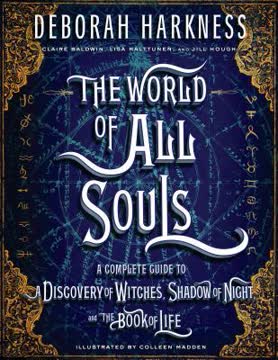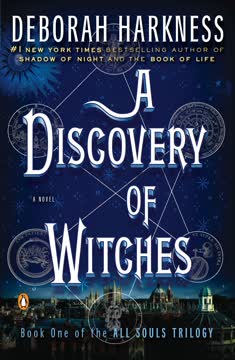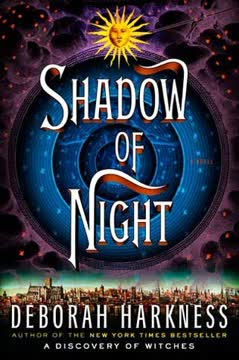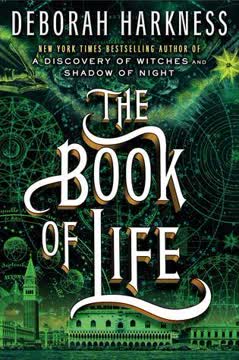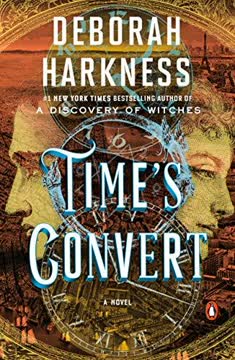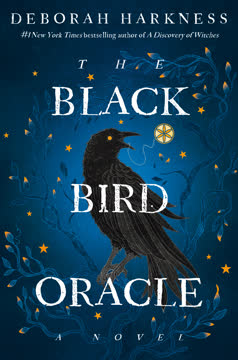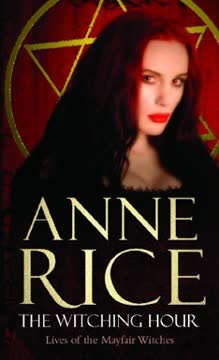Plot Summary
Oxford's Enchanted Discovery
Diana Bishop, a historian and descendant of witches, stumbles upon Ashmole 782, a bewitched manuscript, in Oxford's Bodleian Library. Despite her efforts to avoid magic, the book's allure draws the attention of supernatural creatures—witches, vampires, and daemons—each seeking its secrets. Diana's accidental summoning of the manuscript sets off a chain of events that will upend her carefully constructed, magic-free life and thrust her into a world where history, science, and the supernatural collide.
Creatures in the Shadows
The world is secretly shared by four types of beings: humans, witches, vampires, and daemons. Each has its own history, powers, and prejudices. Witches wield magic, vampires are immortal predators, daemons are creative and unstable, and humans remain largely oblivious. The balance between these groups is maintained by secrecy and a centuries-old agreement, but the discovery of Ashmole 782 threatens to expose old wounds and hidden truths.
The Vampire Scientist's Pursuit
Matthew Clairmont, a 1,500-year-old vampire and renowned geneticist, has searched for Ashmole 782 for generations, believing it holds the key to the origins and fate of all creatures. His scientific investigations into DNA and extinction intersect with Diana's magical heritage, drawing them together. Matthew's quest is both personal and existential, as he fears for the survival of his kind and seeks answers that science alone cannot provide.
Forbidden Love Awakens
As Diana and Matthew's paths intertwine, their mutual attraction grows into a forbidden romance. The laws of the supernatural world, enforced by the Congregation, strictly prohibit relationships between different species. Their love becomes a catalyst for change, challenging the status quo and igniting tensions among witches, vampires, and daemons. Their union is not just a personal risk but a threat to the established order.
The Covenant's Chains
The Congregation, a council of nine (three from each species), upholds the Covenant—a set of rules forbidding interspecies relationships and political involvement in human affairs. The Covenant was created to protect creatures from human persecution but has become a tool of oppression and prejudice. Diana and Matthew's relationship, and the mystery of Ashmole 782, place them in direct conflict with the Congregation's authority.
Flight to Sept-Tours
After threats and attacks from rival witches and vampires, Diana and Matthew flee to Sept-Tours, the de Clermont family's ancestral castle in France. There, Diana faces hostility from Matthew's vampire mother, Ysabeau, and learns more about the complex, hierarchical world of vampires. The castle becomes both sanctuary and crucible, testing their love and forcing Diana to confront her magical potential.
Spellbound and Unbound
Diana's magical abilities, long suppressed by a spell cast by her parents for her protection, begin to surface under duress. Kidnapped and tortured by the witch Satu, Diana discovers the truth of her spellbinding and the vast, unique power she possesses as a weaver—a rare witch who can create new spells. This revelation marks a turning point, as Diana must embrace her identity to survive and protect those she loves.
The Knights of Lazarus
Matthew's role as Grand Master of the Knights of Lazarus, a secret chivalric order founded during the Crusades, is revealed. The order, originally created to protect creatures, wields immense influence and resources. Its history is intertwined with the rise and fall of empires, and its existence is a testament to the enduring power struggles among supernatural beings. Diana's induction into this world deepens her connection to Matthew and the broader conflict.
War of Prejudices
The struggle for Ashmole 782 and the couple's defiance of the Covenant spark open hostilities among witches, vampires, and daemons. Betrayals, kidnappings, and violence escalate as each faction seeks control of the manuscript, believing it holds the secret to their survival or dominance. The personal becomes political, and Diana and Matthew must navigate a web of alliances and enmities that span centuries.
Time's Tapestry Unraveled
To evade the Congregation and find a way to unlock Diana's powers, the couple timewalks to Elizabethan England. Immersed in the world of the School of Night—an elite circle of poets, scientists, and spies—they seek magical tutelage and the missing pages of Ashmole 782. The past is both a refuge and a labyrinth, filled with historical figures, political intrigue, and the ever-present danger of discovery.
School of Night Intrigues
In 1590s London and Prague, Diana and Matthew interact with luminaries like Christopher Marlowe, Mary Sidney, and John Dee. Diana learns from Goody Alsop, a powerful weaver, and discovers her role in the lineage of magical innovation. The search for Ashmole 782 leads them to the courts of power, where alchemy, science, and supernatural politics converge. Their actions in the past have ripple effects, both for history and their own future.
Alchemy and the Book of Life
Ashmole 782 is more than a book—it is a palimpsest of creature DNA, history, and magic, created from the skin, blood, and bones of witches, vampires, and daemons. Its missing pages hold the secret to cross-species origins and the possibility of new life. The alchemical symbolism of the manuscript mirrors Diana and Matthew's union, suggesting that their love may be the key to a new era for all creatures.
Bloodlines and Betrayals
Returning to the present, Diana and Matthew face the consequences of their time in the past. The revelation of Matthew's blood rage—a genetic curse of uncontrollable violence—threatens their family and the fragile alliances they have built. The emergence of Benjamin, Matthew's vengeful vampire son, and the machinations of the Congregation's most ruthless members, force the couple into a final confrontation with the darkest aspects of their legacy.
The Congregation's Judgment
The Congregation, divided and fearful, seeks to maintain control by any means necessary. Diana, now a powerful witch and Philippe de Clermont's blood-sworn daughter, challenges their authority. Through diplomacy, evidence, and the support of allies across all species, she exposes the Covenant's origins in fear and prejudice, and argues for a new understanding based on science, magic, and shared humanity.
The Bright Born Children
Diana and Matthew's twins, Philip and Rebecca, are the first Bright Born—children of a witch and a vampire, embodying the potential for unity and evolution among creatures. Their birth is both a miracle and a threat, forcing the supernatural world to confront its deepest fears about difference and change. The twins' existence becomes the catalyst for the final battle over the future of all species.
Science Meets Magic
The trilogy's climax fuses modern genetics with ancient alchemy, revealing that the distinctions between creatures are not absolute but variations within a single, diverse humanity. Diana's absorption of the Book of Life and Matthew's scientific discoveries prove that witches, vampires, and daemons are not separate species, but branches of the same evolutionary tree. This revelation undermines the rationale for segregation and opens the door to coexistence.
The End of Segregation
With the Covenant repealed and the Congregation reformed, the barriers between creatures begin to dissolve. Diana is appointed as the de Clermont delegate, tasked with ensuring justice and guiding the transition to a more inclusive society. The defeat of Benjamin and the exposure of the true origins of the supernatural world mark the end of an era of fear and division.
A New Age Dawns
The All Souls world enters a new chapter, where science and magic, past and present, and all forms of life are honored. Diana and Matthew's journey—from reluctant witch and haunted vampire to leaders of a new order—serves as a testament to the power of love, knowledge, and the courage to embrace difference. The story closes with hope for a future where all souls, in their diversity, can thrive together.
Characters
Diana Bishop
Diana is a historian and the last of a powerful witch lineage, spellbound as a child to suppress her immense magical abilities. Orphaned and raised by her aunts, she seeks refuge in academia, denying her heritage until Ashmole 782 draws her into the supernatural world. Diana's journey is one of self-acceptance, as she evolves from a fearful, isolated scholar into a formidable weaver—capable of creating new magic—and a unifying force among creatures. Her relationship with Matthew challenges her to reconcile science and magic, love and duty, and ultimately positions her as a leader who bridges ancient divides.
Matthew Clairmont (de Clermont)
Matthew is a 1,500-year-old vampire, scientist, and warrior, burdened by guilt, loss, and the curse of blood rage. As a geneticist, he is obsessed with understanding the origins and fate of creatures, believing Ashmole 782 holds the answers. His love for Diana is transformative, forcing him to confront his violent past and the prejudices of his kind. Matthew's internal struggle between predator and protector, tradition and progress, mirrors the broader conflicts of the All Souls world. His leadership of the Knights of Lazarus and his willingness to defy the Covenant make him both a target and a catalyst for change.
Ysabeau de Clermont
Ysabeau is Matthew's vampire mother, a survivor of centuries of violence and persecution. Initially hostile to Diana, she embodies the old world's fears and prejudices, shaped by the trauma of losing her mate, Philippe, to witch betrayal. Over time, Ysabeau's relationship with Diana softens, and she becomes a fierce protector of her family. Her journey reflects the possibility of healing and adaptation, as she learns to accept change and the breaking of ancient taboos.
Philippe de Clermont
Philippe, though largely absent, is the axis around which the All Souls universe turns. As the founder of the Knights of Lazarus and a key figure in the creation of the Covenant, his legacy shapes the destinies of all creatures. Wise, adaptable, and humane, Philippe's influence endures through his blood-sworn daughter Diana and the values he instilled in his family. His tragic end at the hands of Benjamin and the Nazis haunts the narrative, but his vision of unity and justice guides the story's resolution.
Benjamin Fox (de Clermont)
Benjamin is Matthew's estranged vampire son, a carrier of blood rage and the trilogy's primary antagonist. Driven by a desire for revenge and power, he seeks to exploit the secrets of Ashmole 782 and the potential of cross-species children. Benjamin's cruelty and manipulation of others, including Jack Blackfriars, make him a symbol of the dangers of unchecked prejudice and the destructive potential of the old order.
Goody Alsop
Goody Alsop is a powerful Elizabethan weaver who becomes Diana's teacher and guide in the past. She helps Diana unlock her abilities and understand her unique role in the magical lineage. Goody's wisdom and acceptance of difference contrast with the fear and suspicion of other witches, highlighting the importance of mentorship and tradition in fostering growth and change.
Sarah Bishop
Sarah is Diana's aunt and surrogate mother, a skilled witch rooted in the craft and the customs of her lineage. Protective and outspoken, she struggles to understand Diana's reluctance and the dangers of the supernatural world. Sarah's journey is one of learning to trust in Diana's choices and embracing the possibility of a new future for witches and all creatures.
Marcus Whitmore
Marcus is Matthew's vampire son, a product of the Enlightenment with radical ideas about freedom and equality. His leadership of the Knights of Lazarus and his relationship with Phoebe Taylor symbolize the potential for renewal and adaptation within vampire society. Marcus's struggles with the consequences of blood rage and his own creations reflect the generational tensions at play in the All Souls world.
Hamish Osborne
Hamish is a brilliant daemon and Matthew's closest confidant, offering counsel, perspective, and unwavering support. As a member of the Conventicle, he represents the creative, often marginalized, voice of daemons and the importance of cross-species alliances. Hamish's pragmatism and loyalty are crucial in navigating the political and personal challenges faced by Diana and Matthew.
The Congregation
The Congregation is the governing body of the supernatural world, composed of three witches, three vampires, and three daemons. It enforces the Covenant and maintains the status quo, often through fear and coercion. The Congregation's internal divisions, resistance to change, and eventual transformation under Diana's leadership encapsulate the central conflict between tradition and progress.
Plot Devices
Ashmole 782 / The Book of Life
Ashmole 782 is the central MacGuffin, a bewitched manuscript that contains the origins, history, and genetic secrets of all creatures. Its physical composition—made from the skin, blood, and bones of supernatural beings—symbolizes the interconnectedness of witches, vampires, and daemons. The search for its missing pages drives the plot, while its alchemical and scientific revelations provide the key to breaking down the barriers between species.
The Covenant
The Covenant is an ancient set of laws designed to segregate creatures and prevent interbreeding or political entanglement with humans. It is enforced by the Congregation and serves as both a source of conflict and a metaphor for real-world issues of prejudice, segregation, and fear of difference. The struggle to overturn the Covenant is the narrative's central political arc.
Timewalking
Timewalking, the magical ability to travel to the past, allows Diana and Matthew to seek refuge, knowledge, and allies in Elizabethan England. This device enables the blending of historical fiction with fantasy, introduces real historical figures, and provides a means to explore the roots of the present conflict. The consequences of their actions in the past ripple forward, complicating their quest.
Blood Rage and Genetics
Blood rage, a genetic condition causing uncontrollable violence in vampires, is both a personal and societal threat. Matthew's research into genetics, combined with Diana's magical insights, reveals that the differences between creatures are not absolute but variations within a single species. This fusion of science and magic is both a plot engine and a thematic statement about the nature of identity and evolution.
The Knights of Lazarus
The Knights of Lazarus, a chivalric order founded by Philippe de Clermont, serve as both protectors and power brokers in the supernatural world. Their resources, influence, and history provide the protagonists with allies and tools, while also embodying the complexities of legacy, loyalty, and the burden of the past.
The Conventicle
The Conventicle is a coalition of witches, vampires, and daemons who reject the Covenant and work together to protect Diana, Matthew, and the future of all creatures. Their formation and actions represent the possibility of solidarity across difference and the power of collective action to challenge entrenched systems.
Alchemy and Symbolism
Alchemical imagery—especially the chemical wedding, ouroboros, and the creation of the philosopher's stone—pervades the narrative, mirroring the personal and societal transformations at the heart of the story. These symbols reinforce the themes of integration, renewal, and the breaking of old boundaries.
Analysis
Deborah Harkness's All Souls trilogy, as illuminated by The World of All Souls, is a rich tapestry weaving together fantasy, history, science, and romance to explore the enduring questions of identity, belonging, and the fear of difference. At its core, the series interrogates the artificial boundaries—between species, disciplines, and eras—that divide individuals and communities. Through the journey of Diana and Matthew, the narrative champions the transformative power of love, knowledge, and collaboration, suggesting that true progress comes from embracing complexity and diversity. The fusion of genetics and magic, the overturning of oppressive laws, and the birth of the Bright Born all serve as metaphors for the potential of a more inclusive, interconnected world. In an age marked by polarization and anxiety about change, the All Souls universe offers a hopeful vision: that by confronting our fears, honoring our histories, and daring to unite across difference, we can create a future where all souls—regardless of origin—can thrive.
Last updated:
FAQ
Synopsis & Basic Details
What is The World of All Souls: A Complete Guide to A Discovery of Witches, Shadow of Night, and the Book of Life about?
- An Author's Deep Dive: This guide offers readers an unparalleled look into the intricate universe of Deborah Harkness's All Souls trilogy, moving beyond the narrative to explore its inspirations, lore, and hidden depths. It functions as a comprehensive companion, answering fan questions and revealing the author's creative process.
- Behind-the-Scenes Lore: It meticulously details the characteristics, genetics, customs, and history of the four creature types—witches, vampires, daemons, and humans—alongside an A-Z of characters, organizations, and significant locations. The guide enriches understanding of the trilogy's complex world-building, from the origins of the Congregation to the nuances of elemental magic.
- Interweaving History and Fiction: The book highlights how real-world history, science, and mythology are seamlessly integrated into the fictional narrative, providing context for everything from Elizabethan fashion and alchemical practices to the evolution of scientific thought and the significance of specific historical figures. It showcases Harkness's academic background as a historian of science.
Why should I read The World of All Souls: A Complete Guide to A Discovery of Witches, Shadow of Night, and the Book of Life?
- Unlock Deeper Meanings: For existing fans, this guide offers a treasure trove of information, revealing subtle connections, symbolic layers, and authorial intentions that enhance appreciation for the trilogy's intricate plot and character motivations. It's essential for a comprehensive All Souls analysis.
- Enrich World Immersion: It provides detailed background on the creatures, magic, science, and historical settings, allowing readers to fully immerse themselves in the All Souls universe. The guide transforms passive reading into an active journey of discovery of witches explained and the broader lore.
- Appreciate Authorial Craft: Deborah Harkness shares her inspirations, challenges, and personal insights into the writing process, offering a unique perspective on how a complex fictional world is constructed from historical research and imaginative leaps. It's a must-read for understanding Deborah Harkness's writing style.
What is the background of The World of All Souls: A Complete Guide to A Discovery of Witches, Shadow of Night, and the Book of Life?
- Historian's Creative Spark: Author Deborah Harkness, an academic historian, was inspired to write the trilogy after seeing a display of vampire and witch books at an airport, prompting her to wonder, "If there really are witches and vampires... what on earth do they do for a living?" This question became the genesis of the All Souls trilogy background.
- Deep Research Foundation: Harkness's extensive background in fifteenth- and sixteenth-century history, particularly Elizabethan London and the history of scientific inquiry, provided a rich factual bedrock for the fictional world. She emphasizes that while historical accuracy is important, "historical accuracy is not always the same as historical truth," allowing for creative invention in the Shadow of Night historical context.
- Addressing Reader Curiosity: The guide was created in response to the myriad questions from engaged readers about the trilogy's lore, characters, and intricate details that Harkness couldn't fully address through social media or book signings, serving as a comprehensive All Souls lore explained.
What are the most memorable quotes in The World of All Souls: A Complete Guide to A Discovery of Witches, Shadow of Night, and the Book of Life?
- Defining Creature Nature: "Witches and vampires are monsters to think with." This quote from Deborah Harkness herself encapsulates the thematic depth of the series, suggesting that supernatural creatures serve as powerful metaphors for exploring human prejudices and societal divisions, a key insight into themes in A Discovery of Witches.
- The Essence of Family: "Since time immemorial the family has been an important way for people to organize themselves in the world... the truly traditional basis of family: unqualified love and mutual responsibility." This highlights a core All Souls theme of family, transcending biological ties and creature types, central to the de Clermonts and Bishops.
- Magic and Science Intertwined: "Intellectually, magic and science are compatible rather than conflicting ways to master the natural world. One is not superior to the other—they are different roads to the same end." This quote articulates the trilogy's foundational philosophy, emphasizing the complementary nature of seemingly disparate disciplines in understanding existence, crucial for All Souls magic explained.
What writing style, narrative choices, and literary techniques does Deborah Harkness use?
- Seamless Integration of Research: Harkness masterfully weaves extensive historical and scientific research into the narrative, using it as "seasoning in a stew" rather than dumping it, making the All Souls world-building feel authentic and immersive. This academic rigor underpins the fantastical elements, grounding them in plausible reality.
- Character-Driven Narrative with Agency: Harkness admits that her characters often "seem to have a life of their own," sometimes surprising her and driving the plot in unexpected directions, such as Matthew's spontaneous trip to Hamish. This technique lends a vibrant, organic feel to character development and plot progression, influencing Matthew Clairmont motivations.
- Symbolic and Intertextual Layering: The narrative is rich with symbolism, from alchemical imagery (chemical wedding, ouroboros) to literary allusions (Doctor Faustus, Paradise Lost), which deepen thematic resonance and invite interpretive engagement. Harkness consciously uses these layers to connect individual character journeys to universal human experiences, a hallmark of All Souls symbolism analysis.
Hidden Details & Subtle Connections
What are some minor details that add significant meaning?
- The Bodleian Tote Bag's Irony: Diana carries the Book of Life, now absorbed into her, in a Bodleian Library tote bag inscribed with the reader's oath to "not remove from the Library, or to mark, deface, or injure in any way, any volume." This subtle detail underscores Diana's transformation from a rule-abiding scholar to a powerful witch who has literally embodied the library's most precious, and stolen, secret, highlighting Diana Bishop's character arc.
- Matthew's Consistent Preferences: Matthew's unchanging habits, such as his preference for Montblanc pens, specific car models (Jaguars, Land Rovers), and even his daily rituals, are not just quirks but reflections of his ancient nature. For a being who has lived for centuries, consistency in small things provides a sense of control and stability amidst a constantly changing world, revealing a deeper layer of Matthew Clairmont's psychology.
- The "Spider" Car Naming Convention: Marcus Whitmore's collection of sports cars named after arachnids (Spyker Spyder, Alfa Romeo Spider) is a subtle nod to his predatory vampire nature, even as he embraces Enlightenment ideals. The guide explains these are modern versions of a "spider phaeton," linking his contemporary tastes to historical modes of speed and elegance, adding depth to Marcus Whitmore's character.
What are some subtle foreshadowing and callbacks?
- Philippe's Hidden Note: Philippe's note tucked into the Aurora Consurgens for Ysabeau, hinting at "grandchildren," subtly foreshadows Diana's pregnancy and the birth of the Bright Born twins. This callback from the past reinforces Philippe's prescience and his central, guiding role even after his death, a key element of Philippe de Clermont's legacy.
- The Unplugged Fleetwood Mac Radio: Rebecca Bishop's 1970s clock radio, playing Fleetwood Mac even when unplugged, is a poignant callback to Diana's mother's enduring magical presence and her love for Diana. The song "Rhiannon" (a Welsh witch) and "Don't Stop (Thinking About Tomorrow)" serve as symbolic messages of magical heritage and hope for the future, subtly influencing Diana Bishop's magic.
- Gallowglass's Rune Reading: Gallowglass's consultation of runes, drawing "nyd" (absence and desire) for his present and "odal" (home, family, inheritance) for his future, subtly foreshadows his unrequited love for Diana and his eventual integration into the Bishop-Clairmont scion. The "rad" rune, signifying arrival and departure, perfectly encapsulates his role in Diana and Matthew's journey, offering insight into Gallowglass's motivations.
What are some unexpected character connections?
- Marthe's Ancient Loyalty: Marthe, Ysabeau's seemingly humble housekeeper, is revealed to be an ancient vampire who has survived all the Vampire Wars and possesses "a great deal of ancient lore and information." Her deep, unwavering loyalty to Ysabeau, stemming from Ysabeau freeing her from a blood-rage-infected maker, highlights a profound, centuries-old bond that transcends typical servant-master dynamics, enriching Ysabeau de Clermont's relationships.
- Timothy Weston's Ancestral Link: The quirky daemon Timothy Weston, who possesses one of the missing pages of Ashmole 782, recognized it because it contained the remains of one of his grandfathers. This reveals a direct, personal connection between a seemingly minor character and the central mystery of the Book of Life, emphasizing the deep, often hidden, lineage of creatures and the book's true nature as a record of their DNA, a subtle daemon lore explained.
- Jack Blackfriars's Godfather Role: Jack, the street urchin adopted by Diana and Matthew in 1590, later becomes godfather to Philip Bishop-Clairmont. This unexpected familial bond, spanning centuries and species, underscores the theme of chosen family and the breaking of traditional creature hierarchies, showcasing the evolving Bishop-Clairmont family dynamics.
Who are the most significant supporting characters?
- Marthe, the Unsung Matriarch: Beyond her role as Ysabeau's housekeeper, Marthe is the quiet, competent force that keeps Sept-Tours running, a repository of ancient lore, and a steadfast emotional anchor for Ysabeau. Her premodern perspective on purpose and loyalty provides a grounding contrast to the modern world, making her crucial to the stability of the de Clermont clan and offering a unique perspective on vampire culture.
- Chris Roberts, the Scientific Ally: Diana's human friend and colleague, Chris Roberts, is significant for his open-minded acceptance of the supernatural world, processing evidence "as any open-minded scientist should." His scientific genius and pragmatic approach to creature genetics are indispensable to Matthew's research, symbolizing the potential for human-creature collaboration and challenging the notion of human ignorance, a key aspect of All Souls science explained.
- Goody Alsop, the Weaver Mentor: Goody Alsop is pivotal as Diana's primary magical tutor in Elizabethan London, guiding her to understand her unique powers as a weaver. Her wisdom and emphasis on creating new spells, rather than merely repeating old ones, are essential to Diana's development and the revival of lost magical traditions, highlighting the importance of witchcraft training and the weaver lineage.
Psychological, Emotional, & Relational Analysis
What are some unspoken motivations of the characters?
- Matthew's Redemption Quest: Matthew's relentless pursuit of scientific truth and his protective instincts are deeply rooted in his guilt over his human suicide and the deaths of his first wife and son. His desire to understand blood rage and prevent similar tragedies is an unspoken quest for personal redemption, driving Matthew Clairmont's motivations beyond mere scientific curiosity.
- Ysabeau's Protective Ferocity: Ysabeau's initial hostility towards Diana, and her deep-seated hatred of witches, is a manifestation of her profound grief and trauma from Philippe's torture and death at the hands of Benjamin and the Nazis. Her seemingly cold demeanor masks a fierce, centuries-old protective instinct for her family, shaping Ysabeau de Clermont's emotional arc.
- Gallowglass's Self-Sacrificing Love: Gallowglass's constant presence and unwavering support for Diana, even leading to his departure after the twins' birth, is driven by his unspoken, unrequited love for her. His role as her secret guardian, fulfilling Philippe's command, reveals a deep capacity for self-sacrifice and loyalty, adding a poignant layer to Gallowglass's character analysis.
What psychological complexities do the characters exhibit?
- Diana's Dual Identity Struggle: Diana's psychological complexity stems from her lifelong suppression of her magical identity, leading to anxiety and a reliance on intellect over intuition. Her journey is a profound internal battle to reconcile her academic, rational self with her powerful, instinctive witch self, a central aspect of Diana Bishop's psychological development.
- Daemons' Genius-Madness Tightrope: Daemons like Christopher Marlowe and Timothy Weston exemplify the inherent psychological tightrope walk between "madness and genius." Their intense creativity often comes with instability, impulsivity, and a struggle with repetitive tasks, reflecting a unique neurodivergence that makes them both brilliant and misunderstood, crucial for daemon psychology explained.
- Matthew's Predator-Protector Paradox: Matthew's internal conflict is a constant negotiation between his ancient, predatory vampire nature (including blood rage) and his profound desire for love, family, and intellectual pursuits. This paradox makes him a deeply flawed yet compelling hero, constantly battling his darker impulses to protect those he loves, central to Matthew Clairmont's inner conflict.
What are the major emotional turning points?
- Diana's Witchwater Release: Diana's uncontrolled weeping that turns into witchwater at Sept-Tours, threatening to dissolve her, is a major emotional turning point. It signifies the overwhelming pressure of her suppressed magic and grief, leading to Ysabeau's intervention and the beginning of Diana's acceptance of her powers, a pivotal moment in Diana Bishop's emotional journey.
- Philippe's Forgiveness of Matthew: Philippe's challenge to Matthew, forcing him into a blood rage and then forgiving him for what he "will do" (killing Philippe in the future), is a profound emotional turning point for Matthew. It begins to lift centuries of guilt and allows Matthew to accept his blood rage as part of his identity, crucial for Matthew Clairmont's healing.
- Ysabeau's Acceptance of Diana: Ysabeau's grudging admiration for Diana after the hunting trip, followed by her formal acceptance of Diana as her blood-sworn daughter, marks a significant shift in their relationship. This emotional turning point symbolizes the breaking down of ancient prejudices and the expansion of the de Clermont family, a key aspect of Ysabeau de Clermont's transformation.
How do relationship dynamics evolve?
- Matthew and Diana's Mating Bond: Their relationship evolves from forbidden attraction to a deep, unbreakable mating bond, symbolized by Matthew drinking Diana's blood from her "heart vein." This act of intimacy allows Matthew to "know that nothing is hidden," transforming their connection into a profound sharing of memories and emotions, central to Matthew and Diana's relationship analysis.
- The De Clermont Family's Shifting Hierarchy: The traditional, autocratic de Clermont family hierarchy, with Baldwin as its rigid head, is challenged by Matthew's decision to form his own scion and Diana's appointment as a Congregation delegate. This evolution reflects a move towards a more democratic and inclusive family structure, driven by the needs of the Bright Born children and the repeal of the Covenant, a key aspect of de Clermont family dynamics.
- The Conventicle's Collective Strength: The formation of the Conventicle, uniting diverse creatures (witches, vampires, daemons) in defiance of the Congregation, demonstrates the evolution of interspecies relationships from segregation to solidarity. This alliance, built on mutual respect and shared purpose, showcases the power of collective action to challenge entrenched prejudice, a significant development in All Souls political themes.
Interpretation & Debate
Which parts of the story remain ambiguous or open-ended?
- The Goddess's Unfinished Work: The goddess's repeated pronouncement that she is "not done with Diana yet" and Philippe's return of the golden-silver arrow to Diana, stating "Your work is not done, daughter," leaves Diana's ultimate destiny and future role as the goddess's agent open-ended. This ambiguity suggests ongoing challenges and responsibilities beyond the trilogy's conclusion, prompting questions about Diana Bishop's future.
- Long-Term Creature Integration: While the Covenant is repealed, the guide acknowledges that it will "take time for centuries-old biases to change completely" and for the "divisions between creatures [to be] broken down in reality, too." The full extent and success of creature integration into human society, and among themselves, remains an ongoing process, leaving the future of All Souls creatures open to interpretation.
- The Book of Life's Full Implications: Diana's absorption of the Book of Life means its knowledge is "inextricably part of her," but the full implications of this embodiment are not entirely explored. The book's blank pages and its ability to record new births suggest an ongoing, evolving narrative of creature existence, leaving readers to ponder the depth of Diana's new knowledge and its long-term impact on the world, a key aspect of Ashmole 782 meaning.
What are some debatable, controversial scenes or moments in The World of All Souls: A Complete Guide to A Discovery of Witches, Shadow of Night, and the Book of Life?
- Matthew's Possessiveness and "Ownership": Matthew's declaration "We are one, from this moment forward" and his possessive marking of Diana with his scent can be seen as romantic by some, but controversial by others who view it as a problematic assertion of ownership. Domenico Michele's taunt, "You are the only creature in the world who thinks she belongs to you. Not even Diana Bishop believes it," highlights this tension, sparking debate on Matthew Clairmont's character flaws and the nature of vampire mating.
- The Ethics of Spellbinding: The decision by Diana's parents to spellbind her for her own protection, and Diana's later decision to spellbind Satu Järvinen, raises ethical questions about free will and the use of power. While presented as protective measures, the act of stripping a witch of her magic is inherently controversial, prompting discussion on witchcraft ethics and the morality of intervention.
- Historical Accuracy vs. Narrative License: Deborah Harkness openly discusses her approach to historical accuracy, stating that "a little historical fudge is sometimes necessary to make a story work." This invites debate among readers about the balance between factual fidelity and creative freedom, particularly concerning the portrayal of historical figures and events, a common point of discussion in historical fiction analysis.
The World of All Souls: A Complete Guide to A Discovery of Witches, Shadow of Night, and the Book of Life Ending Explained: How It Ends & What It Means
- Diana's Embodiment of the Book of Life: The ending sees Diana absorbing the text of the Book of Life, making it "inextricably part of her." This signifies her ultimate integration of magic and knowledge, becoming a living repository of creature history and potential. It means the answers to creature origins and future evolution are no longer external or hidden, but reside within her, symbolizing a new era of transparency and self-knowledge for all species, central to The Book of Life ending explained.
- Philippe's Legacy and Diana's Justice: Philippe's ghost returns the golden-silver arrow to Diana, instructing her to "continue Philippe's work of dispensing justice on the goddess's behalf." This positions Diana as Philippe's successor, not just as a de Clermont delegate, but as an agent of cosmic balance and justice, wielding power with wisdom and purpose. It underscores the enduring influence of Philippe's humane vision and Diana's evolved role as a leader, a key aspect of Diana Bishop's destiny.
- A New Age of Intermingling and Hope: The formal repeal of the Covenant and the birth of the Bright Born twins, Philip and Rebecca, herald a "new age" where "procreation between creatures does not result in monsters." This ending signifies the triumph of love, understanding, and scientific truth over centuries of fear and prejudice, offering a hopeful vision for a future where all creatures can coexist and thrive, embodying the core themes in All Souls trilogy.
Review Summary
The World of All Souls is a comprehensive companion guide to the All Souls Trilogy, highly praised by fans for its detailed exploration of characters, locations, and historical context. Readers appreciate the in-depth information, beautiful illustrations, and additional insights into the series' universe. Some found certain sections dry or overwhelming, but most consider it a must-have for devoted fans. The book is best enjoyed after completing the trilogy to avoid spoilers and is valued for enhancing the reading experience and encouraging series revisits.
All Souls Series
Similar Books
Download PDF
Download EPUB
.epub digital book format is ideal for reading ebooks on phones, tablets, and e-readers.
